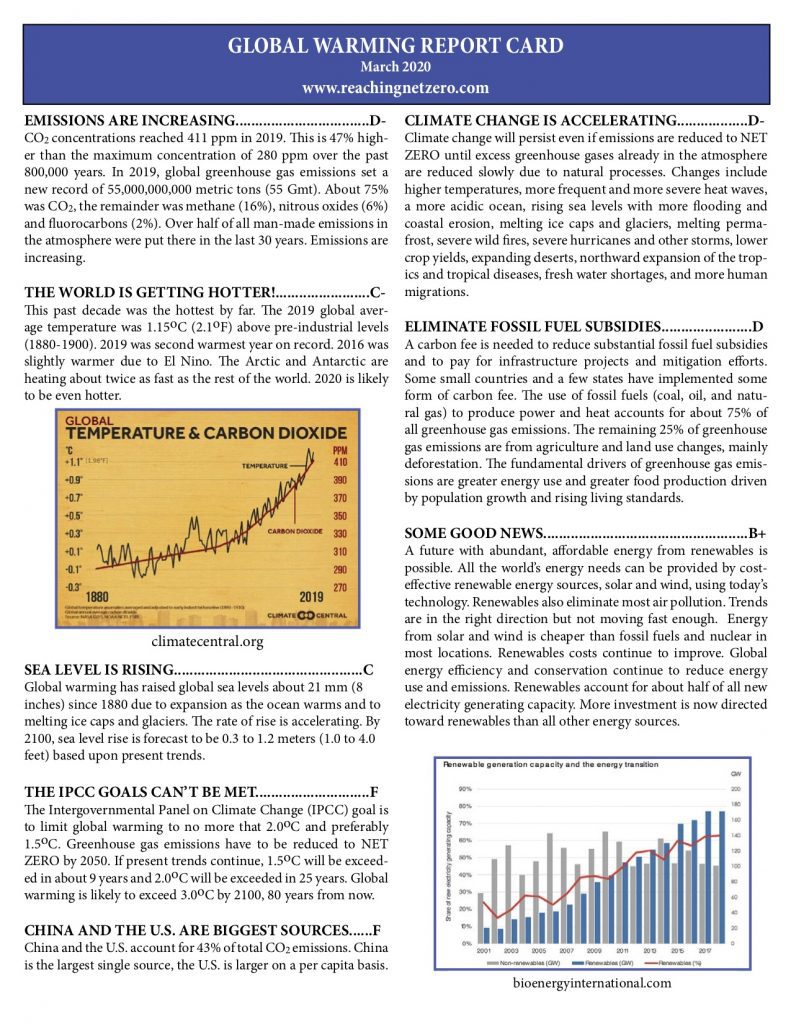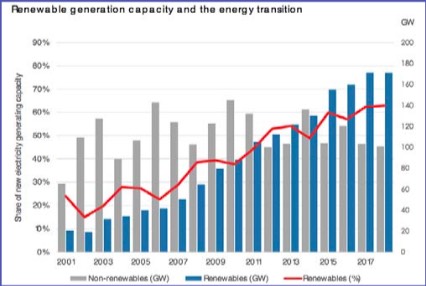Global Warming Report Card
March 2020
EMISSIONS ARE INCREASING
Grade: D-
CO2 concentrations reached 411 ppm in 2019. This is 47% higher than the maximum concentration of 280 ppm over the past 800,000 years. In 2019, global greenhouse gas emissions set a new record of 55,000,000,000 metric tons (55 Gmt). About 75% was CO2, the remainder was methane (16%), nitrous oxides (6%) and fluorocarbons (2%). Over half of all man-made emissions in the atmosphere were put there in the last 30 years. Emissions are increasing.
THE WORLD IS GETTING HOTTER!
Grade: C-
This past decade was the hottest by far. The 2019 global aver- age temperature was 1.15oC (2.1oF) above pre-industrial levels (1880-1900). 2019 was second warmest year on record. 2016 was slightly warmer due to El Nino. The Arctic and Antarctic are heating about twice as fast as the rest of the world. 2020 is likely to be even hotter.
climatecentral.org
SEA LEVEL IS RISING
Grade: C
Global warming has raised global sea levels about 21 mm (8 inches) since 1880 due to expansion as the ocean warms and to melting ice caps and glaciers. The rate of rise is accelerating. By 2100, sea level rise is forecast to be 0.3 to 1.2 meters (1.0 to 4.0 feet) based upon present trends.
THE IPCC GOALS CAN’T BE MET
Grade: F
The Intergovernmental Panel on Climate Change (IPCC) goal is to limit global warming to no more that 2.0oC and preferably 1.5oC. Greenhouse gas emissions have to be reduced to NET ZERO by 2050. If present trends continue, 1.5oC will be exceed- ed in about 9 years and 2.0oC will be exceeded in 25 years. Global warming is likely to exceed 3.0oC by 2100, 80 years from now.
CHINA AND THE U.S. ARE BIGGEST SOURCES
Grade: F
China and the U.S. account for 43% of total CO2 emissions. China is the largest single source, the U.S. is larger on a per capita basis.
CLIMATE CHANGE IS ACCELERATING
Grade: D-
Climate change will persist even if emissions are reduced to NET ZERO until excess greenhouse gases already in the atmosphere are reduced slowly due to natural processes. Changes include higher temperatures, more frequent and more severe heat waves, a more acidic ocean, rising sea levels with more flooding and coastal erosion, melting ice caps and glaciers, melting permafrost, severe wild fires, severe hurricanes and other storms, lower crop yields, expanding deserts, northward expansion of the tropics and tropical diseases, fresh water shortages, and more human migrations.
ELIMINATE FOSSIL FUEL SUBSIDIES
Grade: D
A carbon fee is needed to reduce substantial fossil fuel subsidies and to pay for infrastructure projects and mitigation efforts. Some small countries and a few states have implemented some form of carbon fee. The use of fossil fuels (coal, oil, and natural gas) to produce power and heat accounts for about 75% of all greenhouse gas emissions. The remaining 25% of greenhouse gas emissions are from agriculture and land use changes, mainly deforestation. The fundamental drivers of greenhouse gas emissions are greater energy use and greater food production driven by population growth and rising living standards.
SOME GOOD NEWS
Grade: B+
A future with abundant, affordable energy from renewables is possible. All the world’s energy needs can be provided by cost effective renewable energy sources, solar and wind, using today’s technology. Renewables also eliminate most air pollution. Trends are in the right direction but not moving fast enough. Energy from solar and wind is cheaper than fossil fuels and nuclear in most locations. Renewables costs continue to improve. Global energy efficiency and conservation continue to reduce energy use and emissions. Renewables account for about half of all new electricity generating capacity. More investment is now directed toward renewables than all other energy sources.
bioenergyinternational.com



